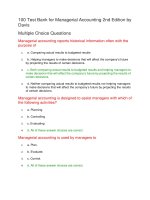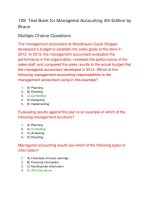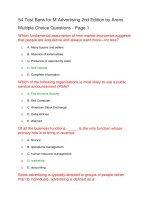Test bank for managerial accounting 2nd edition by whitecotton
Bạn đang xem bản rút gọn của tài liệu. Xem và tải ngay bản đầy đủ của tài liệu tại đây (176.66 KB, 37 trang )
Test Bank for Managerial Accounting 2nd Edition by
Whitecotton
Financial accounting information is generally used exclusively by
internal parties such as managers.
1.
True
2.
False
Financial accounting information is prepared according to generally
accepted accounting principles.
1.
True
2.
False
Managerial accounting information includes such items as budgets,
performance evaluations, and cost reports.
1.
True
2.
False
Financial accounting information is reported for the company as a
whole.
1.
True
2.
False
Investors, creditors and regulators are the primary users of managerial
accounting nformation.
1.
True
2.
False
The planning function is the arranging of the necessary resources to
carry out the plan.
1.
True
2.
False
The control function is comparing actual with budgeted results and
taking corrective action when needed.
1.
True
2.
False
The directing/leading function provides motivation to achieve
results.
1.
True
2.
False
Managers of small, private corporations use managerial accounting
information whereas managers of large, public corporations use
financial accounting information.
1.
True
2.
False
Since hospitals, universities, and charitable organizations do not exist
strictly to earn profit for shareholders, managerial accounting
information is not vital to their operations.
1.
True
2.
False
The Sarbanes-Oxley Act of 2002 places full responsibility on the board
of directors for the accuracy of the reporting system.
1.
True
2.
False
Properly applied, ethics provide a clear right or wrong answer to the
business situations facing accountants and managers.
1.
True
2.
False
The Sarbanes-Oxley Act of 2002 focuses on three factors that affect the
accounting reporting environment: ethics, fraud, and managers.
1.
True
2.
False
Although there are numerous ways to categorize costs, each individual
cost will only be classified in one particular way.
1.
True
2.
False
Costs can be sorted or categorized in a number of ways including
relevant or irrelevant costs.
1.
True
2.
False
Out-of-pocket costs involve an actual outlay of cash.
1.
True
2.
False
Opportunity cost is the cost of not doing something.
1.
True
2.
False
Whether a cost is treated as direct or indirect depends on whether
tracing the cost is either possible or feasible.
1.
True
2.
False
An indirect cost can be readily traced to a cost object while a direct cost
is traced only to manufacturing costs.
1.
True
2.
False
Variable costs are always direct costs.
1.
True
2.
False
Fixed costs stay the same, on a per-unit basis, as activity level
changes.
1.
True
2.
False - Given
Fixed costs stay the same, in total, as activity level changes.
1.
True
2.
False
Prime costs include direct materials, direct labor, and manufacturing
overhead.
1.
True
2.
False
Conversion costs are the costs to convert direct materials into the
finished product.
1.
True
2.
False
A manufacturing firm reports only manufacturing costs.
1.
True
2.
False
All manufacturing costs are treated as product costs.
1.
True
2.
False
All manufacturing costs are inventoriable costs.
1.
True
2.
False
A cost that will occur in the future and differs between various
alternatives under consideration is a relevant cost.
1.
True
2.
False
What is the primary goal of accounting?
1.
A. To set long-term goals and objectives.
2.
B. To arrange for the necessary resources to achieve a plan.
3.
C. To provide information for decision making.
4.
D. To motivate others to work towards a plan's success.
Accounting is primarily intended to facilitate
1.
A. starting a business.
2.
B. decision making.
3.
C. ethics investigations.
4.
D. cost tracing.
Which of the following is not a characteristic of financial
accounting?
1.
A. Financial reports are prepared according to GAAP.
2.
B. Information is used by external parties.
3.
C. Information is subjective, relevant and future-oriented.
4.
D. Reports are prepared periodically.
Which of the following is not a characteristic of financial
accounting?
1.
A. Information is reported at the decision making level.
2.
B. Information is used by external parties.
3.
C. Information is objective, reliable and historical.
4.
D. Reports are prepared periodically.
Which of the following is not a characteristic of financial
accounting?
1.
A. Financial reports are prepared according to GAAP.
2.
B. Information is used primarily by internal parties.
3.
C. Information is objective, reliable and historical.
4.
D. Reports are prepared periodically.
Which of the following is not a characteristic of managerial
accounting?
1.
A. Information is used by internal parties.
2.
B. Information is subjective, relevant, future-oriented.
3.
C. Reports are prepared as needed.
4.
D. Reports are prepared according to GAAP.
Which of the following is not a characteristic of managerial
accounting?
1.
A. Information is used by external parties.
2.
B. Information is subjective, relevant, future-oriented.
3.
C. Reports are prepared as needed.
4.
D. Information is reported at the decision making level.
Which of the following is not a characteristic of managerial
accounting?
1.
A. Information is used by internal parties.
2.
B. Information is subjective, relevant, future-oriented.
3.
C. Reports are prepared as needed.
4.
D. Information is reported for the company as a whole.
Which of the following types of reports is more characteristic of
managerial accounting than financial accounting?
1.
A. An internal report used by management.
2.
B. An external report used by investors.
3.
C. A report prepared according to GAAP.
4.
D. A report prepared periodically (monthly, quarterly, annually).
Which of the following types of organizations purchases raw materials
from suppliers and uses them to create a finished product?
1.
A. Manufacturing firms
2.
B. Merchandising companies
3.
C. Service companies
4.
D. Retailers
Hair salons and law firms are which of the following type of
organization?
1.
A. Retailers
2.
B. Service companies
3.
C. Manufacturing firms
4.
D. Merchandising companies
Which of the following types of organizations sells goods to the general
public?
1.
A. Service companies - Given
2.
B. Manufacturing firms
3.
C. Merchandising companies
4.
D. Retailers
Which of the following functions of management involves taking actions
to implement the plan?
1.
A. Planning
2.
B. Organizing
3.
C. Directing/leading
4.
D. Control
Which of the following functions of management involves comparing
actual results with budgeted results?
1.
A. Planning
2.
B. Organizing
3.
C. Directing/leading
4.
D. Control
Which of the following functions of management involves setting short
and long-term objectives and the tactics to achieve them?
1.
A. Planning
2.
B. Organizing
3.
C. Directing/leading
4.
D. Control
Which of the following functions of management involves arranging the
necessary resources to carry out the plan?
1.
A. Planning
2.
B. Organizing
3.
C. Directing/leading
4.
D. Control
Which of the following functions of management involves providing
motivation to achieve results?
1.
A. Planning
2.
B. Organizing
3.
C. Directing/leading
4.
D. Control
Which of the following functions of management involves taking
corrective action if needed?
1.
A. Planning
2.
B. Organizing
3.
C. Directing/leading
4.
D. Control
Which of the following functions of management involves providing
feedback for future plans?
1.
A. Planning
2.
B. Organizing
3.
C. Directing/leading
4.
D. Control
Which of the following is the correct sequencing of the managerial
process?
1.
A. Planning - Organizing - Control - Directing/Leading
2.
B. Planning - Directing/Leading - Organizing - Control
3.
C. Planning - Organizing - Directing/Leading - Control
4.
D. Organizing - Directing/Leading - Planning - Control
Which of the following describes the Planning function of
management?
1.
A. Setting short and long-term objectives
2.
B. Comparing actual to budgeted results and taking corrective
action
3.
C. Taking actions to implement the plan
4.
D. Arranging the necessary resources to carry out the plan
Which of the following describes the Control function of
management?
1.
A. Setting short and long-term objectives
2.
B. Comparing actual to budgeted results and taking corrective
action
3.
C. Taking actions to implement the plan
4.
D. Arranging the necessary resources to carry out the plan
Which of the following describes the Organizing function of
management?
1.
A. Setting short and long-term objectives
2.
B. Comparing actual to budgeted results and taking corrective
action if needed
3.
C. Taking actions to implement the plan
4.
D. Arranging the necessary resources to carry out the plan
Which of the following describes one of the Directing/Leading functions
of management?
1.
A. Setting short and long-term objectives
2.
B. Comparing actual to budgeted results and taking corrective
action
3.
C. Taking actions to implement the plan
4.
D. Arranging the necessary resources to carry out the plan
Which of the following does the term "ethics" not refer to?
1.
A. The standards of conduct for judging fair from unfair
2.
B. The standards of conduct for judging right from wrong
3.
C. The standards of conduct for judging opportunity from
incentives
4.
D. The standards of conduct for judging honest from dishonest
Which of the following is not one of the factors affecting the accounting
reporting environment focused on by the Sarbanes-Oxley Act?
1.
A. Line of business
2.
B. Opportunity
3.
C. Character
4.
D. Incentives
Which of the following is a requirement under the Sarbanes-Oxley
Act?
1.
A. Financial statements must be audited by a Big Four accounting
firm.
2.
B. Management must issue a report that indicates whether the
financial statements are free of error.
3.
C. Management must conduct a review of the company's internal
control system.
4.
D. Background checks must be performed on all employees.
Which of the following is not a provision of the Sarbanes-Oxley Act?
1.
A. Executives can avoid penalties for fraud by declaring personal
bankruptcy.
2.
B. Stiffer penalties for fraud in terms of monetary fines and jail
time.
3.
C. Public companies must adopt a code of ethics for senior
financial officers.
4.
D. Management must issue a report that indicates whether internal
controls are effective at preventing errors and fraud.
Which of the following is not true about how the Sarbanes-Oxley Act
counteracts incentives for committing fraud?
1.
A. It provides for stiffer monetary penalties.
2.
B. It increases the maximum jail sentence for fraudulent reporting.
3.
C. It removes legal protection from whistleblowers.
4.
D. It provides that violators must repay any money obtained via
fraud plus pay fines.
The Sarbanes-Oxley Act places responsibility for the accuracy of the
reporting system on
1.
A. Accounting managers.
2.
B. Marketing managers.
3.
C. Top executives.
4.
D. All managers.
Which of the following changes introduced by the Sarbanes-Oxley Act is
not one intended to reduce opportunities for error and fraud?
1.
A. Internal control report from management
2.
B. Code of ethics
3.
C. Stronger oversight by directors
4.
D. Internal control audit by external auditors
Which of the following changes introduced by the Sarbanes-Oxley Act is
not one intended to encourage good character?
1.
A. Anonymous tip lines
2.
B. Whistle-blower protection
3.
C. Code of ethics
4.
D. Stiffer fines and prison terms
Which of the following changes introduced by the Sarbanes-Oxley Act is
intended to counteract incentives for fraud?
1.
A. Stronger oversight by directors
2.
B. Code of ethics
3.
C. Stiffer fines and prison terms
4.
D. Anonymous tip lines
Which of the following is not true about how the Sarbanes-Oxley Act
emphasizes the importance of the character of managers and
employees?
1.
A. It requires that ethics be embedded in the organizational culture.
2.
B. It requires that audit committees establish anonymous tip lines.
3.
C. It provides protection for whistle-blowers.
4.
D. It requires that public companies adopt a code of ethics for
senior financial officers.
Which of the following is not one of the categories used to sort costs in
managerial accounting?
1.
A. Relevant or irrelevant
2.
B. Variable or fixed
3.
C. Out-of-pocket or opportunity
4.
D. Direct or indirect
Which of the following statements concerning costs is incorrect?
1.
A. Costs are treated differently depending on how the information
will be used.
2.
B. Out-of-pocket costs include the costs associated with not taking
a particular course of action.
3.
C. Any single cost can be classified in more than one way.
4.
D. Costs can be categorized on the basis of relevant or irrelevant
costs.
The cost of not doing something is a(n)
1.
A. out-of-pocket cost.
2.
B. opportunity cost.
3.
C. direct cost.
4.
D. cost object.
An actual outlay of cash is a(n)
1.
A. out-of-pocket cost.
2.
B. opportunity cost.
3.
C. direct cost.
4.
D. cost object.
An opportunity cost is
1.
A. the foregone benefit of the path not taken.
2.
B. an actual outlay of cash.
3.
C. the initial investment required to pursue an opportunity.
4.
D. a cost that cannot be traced to a specific cost object.
An out-of-pocket cost involves which of the following?
1.
A. Choosing to do one thing instead of another.
2.
B. Tracing the cost directly to a cost object.
3.
C. An actual outlay of cash.
4.
D. Determining how the cost changes with a change in activity
level.
To earn summer money, Joe could mow lawns in his neighborhood, or
he could work at a local grocery store. Which of the following is an
opportunity cost of mowing lawns?
1.
A. Cash paid for gas to run the lawnmower.
2.
B. The time spent mowing the lawns.
3.
C. The wages he could have earned working at the grocery store.
4.
D. Depreciation on the lawnmower.
To earn summer money, Joe could mow lawns in his neighborhood, or
he could work at a local grocery store. Which of the following is an outof-pocket cost of mowing lawns?
1.
A. The use of his father's truck to get to job sites.
2.
B. The wages he could have earned working at the grocery store.
3.
C. The time spent mowing the lawns.
4.
D. Cash paid for gas to run the lawnmower.
Which of the following cannot be an out-of-pocket cost?
1.
A. A direct cost.
2.
B. An opportunity cost.
3.
C. A variable cost.
4.
D. A period cost.
Costs that can be traced to a specific cost object are
1.
A. opportunity costs.
2.
B. direct costs.
3.
C. indirect costs.
4.
D. irrelevant costs.
Costs that are not worth the effort to trace to a specific cost object
are
1.
A. opportunity costs.
2.
B. direct costs.
3.
C. indirect costs.
4.
D. irrelevant costs.
A direct cost is one which
1.
A. involves an actual outlay of cash for a specific cost object.
2.
B. can be traced to a specific cost object.
3.
C. cannot be traced to a specific cost object.
4.
D. is not worth the effort of tracing to a specific cost object.
What determines the difference between a direct and an indirect
cost?
1.
A. Whether it changes when activity levels change.
2.
B. Whether it is relevant to a particular decision.
3.
C. Whether it can be traced to a specific cost object.
4.
D. Whether it is related to manufacturing or nonmanufacturing
activities.
Which of the following is an indirect cost of manufacturing a table made
of wood and glass, for a firm that manufactures furniture?
1.
A. The cost of the wood in the table.
2.
B. The cost of the labor used to assemble the table.
3.
C. The cost of the glass in the table.
4.
D. The cost of rent on the factory where the table is manufactured.
Which of the following is a direct cost of manufacturing a table made of
wood and glass, for a firm that manufactures furniture?
1.
A. The cost of the wood in the table.
2.
B. The cost of rent on the factory where the table is manufactured.
3.
C. The salary of the supervisor who oversees all production for the
firm.
4.
D. Depreciation on the tools used to manufacture the table.
A cost object is
1.
A. an item for which managers are trying to determine the cost.
2.
B. an item to which managers must directly trace costs.
3.
C. an item to which it is not worth the effort of tracing costs.
4.
D. an item for sale by a business.
Indirect costs are
1.
A. costs that are not worth the effort to trace to a specific cost
object.
2.
B. costs that change, in total, in direct proportion to changes in
activity levels.
3.
C. always irrelevant.
4.
D. costs that remain constant no matter the activity level.









